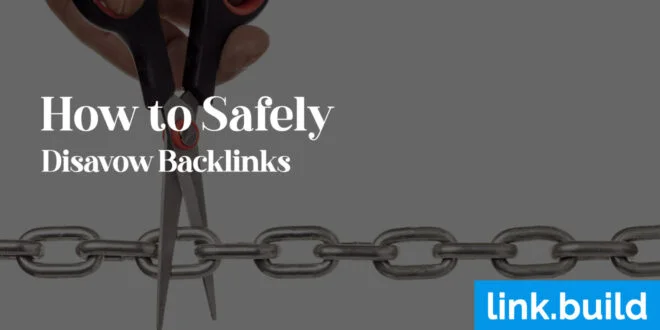Effective Link Prospecting: A Practical Handbook

Link prospecting is the core of any successful link building strategy. It’s a combination of understanding what keywords will gain quality links, using search engine operators to identify the right target websites, vetting sites through analysis, and finding appropriate contact information for outreach efforts.
If your content isn't good enough to earn links, then you'll probably have to beg, borrow and steal to get them.
Learning how to do effective link prospecting can also position brands and organizations as trusted authorities in their respective niches and connect them with opportunities that will help them reach more audiences and increase brand visibility. This practical handbook identifies the steps necessary in implementing an effective link prospecting process.
Specifically, it outlines the essential topics related to understanding keyword research for new prospects, leveraging search operators for reaching out to those prospects, analyzing procedures while vetting sites, and discovering valuable contacts then goes on further describe the best tools and practices for improving prospecting programs.
In conclusion, readers will receive an understanding of link-building fundamentals and methods for obtaining quality links that provide value to brands’ own websites.
Link Prospecting
.webp)
Role of Keywords in Link Prospecting
Link prospecting keywords play a key role in the effectiveness of any link building campaign, as they help to determine which sites should be targeted for outreach. Keyword research must be conducted thoroughly and strategically so that it can accurately identify relevant websites that will add the most value to a website’s link portfolio.
Spend time testing keyword combinations so as to focus on more specific terms that cover niche topics, as well as short-tail vs long-tail search inquiries. Additionally, keep an eye out for unique keyword modifiers and alternative phrases such that efforts are hyper-targeted and give each of your prospects maximum exposure potential within search engines.
By getting creative with relevant terms, a solid list of reliable leads or prospective link targets can quickly be developed from researching prospects based on specific industry-related keywords.
Conducting Keyword Research for Link Building
Conducting a keyword research for link building requires a detailed understanding of relevance and popularity. It is advisable to pick relevant keywords that accurately describe the content on your page, as well as popular keywords which will draw more organic traffic from users who search for those specific terms.
Knowing related industry topics can also assist in including domain-specific phrases in your research, making sure that you target possible links within domains engaged with a specific field. Finding relevant influencers and their audience might help to choose “related words”.
Analyzing competition and evaluating trending topics usually provide fruitful information regarding what works/does not work strategically deciding on more promising prospects ahead.
Identifying Targeted Keywords for Link Prospecting
Identifying targeted keywords for link prospecting will involve identifying the main topics or themes that interest and engage your target audience. To do this, begin by constructing a list of relevant topics based on research into your industry, simply brainstorming ideas and seeing what others are talking about in the conversation around similar companies or interests.
From there, you can conduct keyword research using tools like Google’s Keyword Planner to identify key terms with appropriate levels of organic traffic, difficulty, and competition as well as volume-based “long-tail” phrases - such as combinations of related terms and product attributes - in order to zero in on those targeted phrases for use when searching webpages and sites for achieving successful link acquisition.
Search Operators for Link Prospecting
.webp)
Search operators are commands used to modify user searches in a way that can help discover desired information more rapidly.
In link prospecting, particular kinds of search operators can be employed to quickly locate promising sites for which to build links. Search operators enable keyword-specific and URL-specific searching, as well as titling and anchor text research.
Generally speaking, they help to narrow the focus of online searches and return more accurate results- essential when seeking out useful web sources during the link building efforts.
Depending on the stage of prospecting and the type of research required, different search operators can be utilized to effectively and thoroughly perform link prospecting activities.
Commonly Used Search Operators for Link Prospecting
1. Site: Operator for Domain-Specific Search
The site: operator is one of the most commonly used search operators for link prospecting as it helps to locate pages within a specified domain.
By appending 'site:' before a particular abbreviation, using this asset efficiently will restrict your query specifically to that website's confines and in the search results showcase any related results from there.
This can be especially handy in ascertaining suitable resource links or websites you were searching for but lacked information about and useful if done frequently since repeated searches by indexers and spiders easily reveal questions served that website's reliance on several key topics/maxims/themes.
You can even use this to source broken link opportunities.
2. Intext: Operator for Keyword-Specific Search
The Intext: operator is a useful search operator for keyword-specific link prospecting. This tool allows you to look for specific words in the page content, instead of the title or URL itself, thereby targeting websites with pages containing relevant content more accurately.
Additionally, this advanced search operator supports Boolean functions and phrase queries to further narrow down your searches for improved efficiency.
For example a keyword query such as ‘Intext: “affordable pet care” can be used to find webpages with text referring to affordable care within the blog section specifically. Therefore this enables finding websites with consistent relevance and higher relevancy which results in far better quality potential links later on in link building cycles.
3. Inanchor: Operator for Anchor Text-Specific Search
The Inanchor search operator is a powerful tool for link prospecting, as it enables you to identify websites and webpages that host content with exact or similar anchor text terms. By typing "inanchor:[anchor_text]" into the search bar - without quotation marks – Google will deliver results consisting of pages or websites with relevant anchor texts included in their hyperlinks.
The resulting search results can help you create an effective link building strategy by recognizing domains currently associated with booming subject authority and potential opportunities for a guest post, profiles, citations, sponsored links exchanges, etc.
It's important to also keep interpreting Google's suggestions for ‘related report’ keywords to discover more expert sites inside your researching niche. Through such knowledge-gaining Link Prospecting you increase your visibility to lucrative yet competitive markets that possess high-page relevance and prospective future success.
4. Intitle: Operator for Title-Specific Search
The intitle: search operator can be used to great effect when it comes to link prospecting for a website or blog.
This particular operator is used in searches to find page titles that contain precisely the right words and phrases.
Since most webpages have as their titles some rhetoric related to their content, understanding what this might consist of makes it easy to discover leads that are both relevant but also unexpectedly good prospects during your mission to research those audiences.
5. Filetype: Operator for File Extension-Specific Search
The Filetype search operator is a handy tool used in link prospecting when specializing your searches to certain file extensions. This type of operator gives users the ability to limit their search results down to any specific format, allowing you to source webpages only containing documents or graphics with particular extensions, such as .pdf, .imagepx, etc.
With this specific example, having specialized asset libraries can offer high-opportunity prospects, determining sometimes hard-to-find outposts and associating them with freshly indexed content.
In fact, using the ‘Filetype’ function correctly can expand outreach tactics beyond generic searching offering valuable links elsewhere which wouldn't be found via simply Google search results.
Advanced Search Operators for Enhanced Link Prospecting
.webp)
Search engine search operators are powerful link prospecting tools. While many of the automated and manual tools used in the research process rely upon simple keyword searches for project research, additional searching intensity can be achieved through more focused queries with special parameters.
Advanced search operators allow Internet surfers to direct searches in targeted, sophisticated directions and provide methods for a stream-lined SEO review that otherwise are difficult to obtain on one's own. Common advanced search modifications consist of file types like "filetype: pdf".
Other functions provided by operators allow users to develop more precisely targeted strings created from suffixes (.edu or .gov), word wildcards (magazine), regular expressions (e.g., different grammatical forms responding to relevant words), and other wildcard asterisks.
Vetting Sites for Link Building
This section will focus on the importance of vetting sites for link building. Vetting authoritative websites before adding a backlink is an essential practice that can save much time and energy which would otherwise be wasted going after bad links or eventually having bad links removed.
By thoroughly researching and overturning each website to assess its metrics, relevance, trustworthiness, audience engagement levels, content quality, and other guidelines according to your global marketing strategy which must be taken into account for successful link building campaigning.
Evaluating Site Relevance and Authority
1. Analyzing Domain Authority and Page Authority
.webp)
Analyzing a website's domain authority and page authority is essential for evaluating whether or not the site is suitable for link building. Domain Authority (DA) measures a website’s general quality and strength while Page Authority (PA) looks at the relative importance of a specific page on that website.
High scores are indicative of a good prospect, yet each metric alone cannot be entirely relied upon to determine if the site will be relevant to one’s own link prospecting requirements. Nonetheless, DA/ PA are incredibly useful metrics for directing attention towards certain sites during link building tasks.
2. Assessing Site Traffic and Engagement Metrics
Assessing site traffic and engagement metrics is an essential step within link prospecting when evaluating current or potential relevant sites. This gives an overview of whether a website may be beneficial to the data set or if its quality isn't built conducive for linking purposes.
Being able to track visits analytics, referring domains, organic search positions, and social share count creates a better viewpoint in gauging the relevancy of the overall substance in order to ensure mutual success, on either denominated party encouraged.
3. Examining Site Niche Relevance and Content Quality
When evaluating website relevance and authority for link building, the niche relevance and content quality of the site are paramount. Niche relevance encapsulates how well your own website aligns with that you back.
Relevancy provides autonomy to choose sites devoted to ensuring a higher likelihood of increased credibility within your business´s industry. Additionally, it’s essential that you evaluate content quality by looking for objective opinions cloaked in insight rather than rife motives tasked toward rank manipulation.
This type of on-site examination essentially identifies websites necessary to brainstorm intelligent strategies needed to be aimed at deepening contextual understanding.
Avoiding Red Flags and Spammy Websites
It is important to assess the relevance and authority when vetting sites for link building. Of special importance, though, is avoiding sites with red flags and those that are less reputable, or considered ‘spammy’ websites.
This should include elements such as spammy links on a website (coming from low-quality, untrustworthy domains), being inadequately natural (in terms of anchor text or overarching topics), having duplicate content littered throughout the site, containing viruses/malware, etc..
These all signify red flags that one needs to be cognizant of while evaluating websites; merely associated with these unintentional effects can do major damage to your strategy and cause irreparable reputation consequences.
Finding Contact Information for Link Building
Contact Information Retrieval
.webp)
Finding contact information related to link building processes can seem like an arduous process at first. Fortunately, the advent of modern technologies has allowed us to look for contacts in a far more automated fashion.
Manual link building methods have become outdated as we transition towards complex yet effective tools that are developed specifically for link building campaigns. Generating leads was also a nuisance before and now email search options are available at prices small businesses can afford.
Overall, retrieval of contact info is achievable faster than ever if we utilize our resources correctly in locating their whereabouts on the opposite online channels.
Manual Methods for Finding Contact Information
1. Exploring the "Contact" or "About Us" Page
Exploring the "Contact" or “About Us” page is a reliable way to quickly and easily obtain contact information. To get started, do internet research into the site for its contact username/URL web address.
Review homepage sections carefully, such as header and footer menus. Technical directories can also list website owners from domain registrar records. You can find key member information in a team or board of directors tab too which will offer bios, social media links plus email contact where applicable.
2. Searching Social Media Profiles and Bios
Manually searching social media profiles and bios can be a powerful way of finding contact information. To initiate these searches, it does help to have a target or suspected individual in mind.
Once identified, one can cross-reference profiles across various channels such as LinkedIn, Twitter, and Facebook which will reveal pertinent profile info including email addresses and bio blurbs about targets' interests and affiliations.
Utilizing contextual intelligence during these judgments decisions makes it easier to further extract meaning for decisions moving forward.
3. Reaching Out Through Email Outreach Tools
Reaching out through email outreach tools, often used by marketing teams, is gradually gaining importance in link building. They are the channels voice influencers can use to reach multiple contacts for building links simultaneously.
Email outreach works by tracking opens, clicks, and which content has more connection with influencers. Through this approach opportunities for link building can be unearthed conveniently instead of blindly asking website owners to build relationships with them without even knowing if they'll take any interest in it.
Similarly emotional context triggers create a closer engagement from their customer’s emotion to better understand mutual grounds effectively that spark off unbreakable links connection coinciding further endeavors.
Automated Tools for Contact Information Discovery
Automated Tools for Contact Information Discovery allow link-building professionals to quickly find the contact information they need to outreach potential websites. Popular platforms such as Hunter, Lead Navigator, and Anymail Finder make finding emails easier than before by extracting these contact details from online sources like social media, blogs, and corporate websites.
The great advantage of automated contact information research tools is that an extensive list of valuable prospects can be populated within a negligible timeframe- helping save up hours of manual searches each day.
Conclusion
Overall, this blog post serves as a comprehensive guide to practical link prospecting efforts. Link prospecting is all about identifying untapped sources for link building opportunities while researching and efficiently utilizing the appropriate time-saving tools is essential to accelerate this process.
With an understanding of keywords and search operators relevant to link prospecting one can potentially abstract valuable insight through properly sifting sites and gathering contact information ahead of time to drive beneficial progress throughout the reputation-building journey at hand.
Learning how to correctly employ these methods will be worthwhile gains when it comes to establishing exact fit connections with forward-thinking growth prospects.


.svg)

.jpg)
.jpg)
